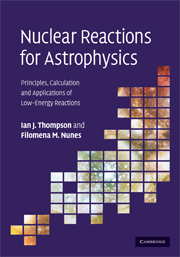Book contents
- Frontmatter
- Contents
- Preface
- Sources of quotations
- Acknowledgements
- 1 Nuclei in the Cosmos
- 2 Reactions of nuclei
- 3 Scattering theory
- 4 Reaction mechanisms
- 5 Connecting structure with reactions
- 6 Solving the equations
- 7 Approximate solutions
- 8 Breakup
- 9 Three-body nuclei
- 10 R-matrix phenomenology
- 11 Compound-nucleus averaging
- 12 Stellar reaction rates and networks
- 13 Connection to experiments
- 14 Spectroscopy
- 15 Fitting data
- Appendix A Symbols
- Appendix B Getting started with Fresco
- Select bibliography
- Index
Appendix B - Getting started with Fresco
Published online by Cambridge University Press: 05 March 2012
- Frontmatter
- Contents
- Preface
- Sources of quotations
- Acknowledgements
- 1 Nuclei in the Cosmos
- 2 Reactions of nuclei
- 3 Scattering theory
- 4 Reaction mechanisms
- 5 Connecting structure with reactions
- 6 Solving the equations
- 7 Approximate solutions
- 8 Breakup
- 9 Three-body nuclei
- 10 R-matrix phenomenology
- 11 Compound-nucleus averaging
- 12 Stellar reaction rates and networks
- 13 Connection to experiments
- 14 Spectroscopy
- 15 Fitting data
- Appendix A Symbols
- Appendix B Getting started with Fresco
- Select bibliography
- Index
Summary
General structure
Fresco is a general-purpose reaction code, created and frequently updated by Ian Thompson. The code calculates virtually any nuclear reaction which can be expressed in a coupled-channel form. There is a public version of the code which can be downloaded from the website www.fresco.org.uk. Fresco is accompanied by Sfresco, a wrapper code that calls Fresco for data fitting and sumbins and sumxen, two auxiliary codes for integrated cross sections. Although we do not include it here, in the same site you can also find xfresco the front-end program to Fresco for X-window displays.
Its original version was written in Fortran 77 but some important sections were ported to Fortran 90.An important part concerns the input, which now uses namelist format, making it much easier to view the relevant variables. In this section we will discuss the general namelist format of the Fresco input.
There are several different layers of output produced by Fresco. The default output contains the most important information concerning the calculation, repeating the input information, and the resulting observables but most detailed information is contained in the generated fort files, including files ready for plotting purposes. At the end of this section we present the list of output produced by Fresco.
Input file
Input files contain five major namelists regarding different aspects of the calculation: fresco, partition, pot, overlap, coupling.
- Type
- Chapter
- Information
- Nuclear Reactions for AstrophysicsPrinciples, Calculation and Applications of Low-Energy Reactions, pp. 433 - 454Publisher: Cambridge University PressPrint publication year: 2009



